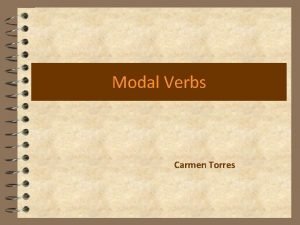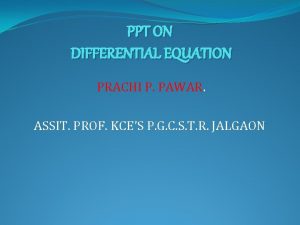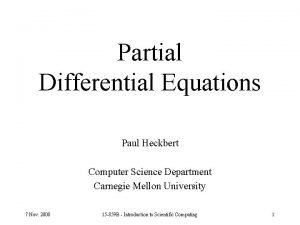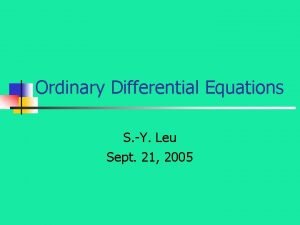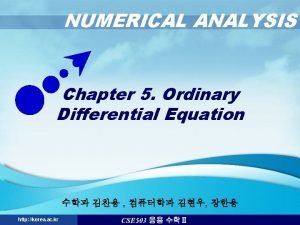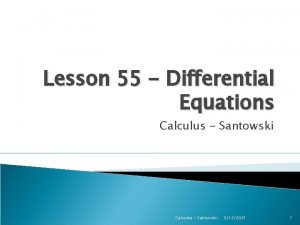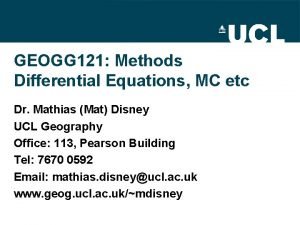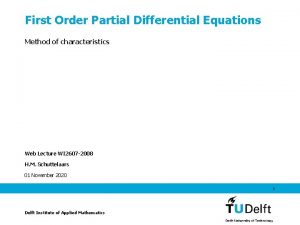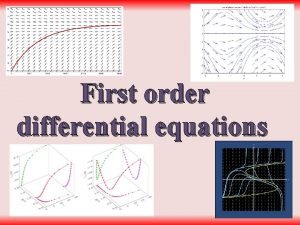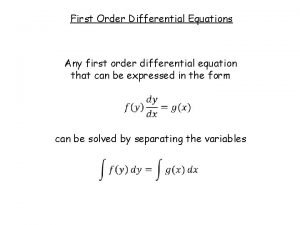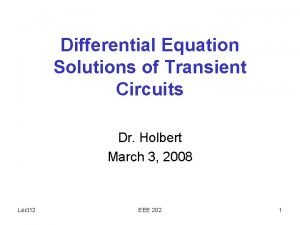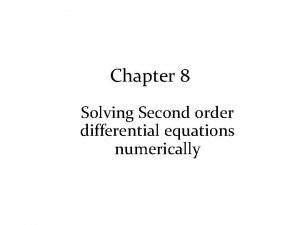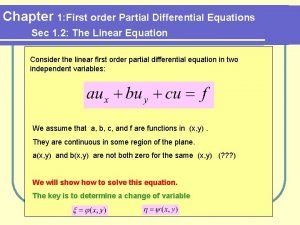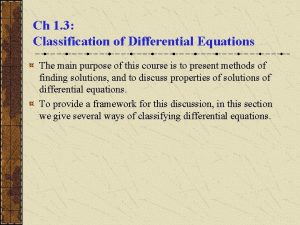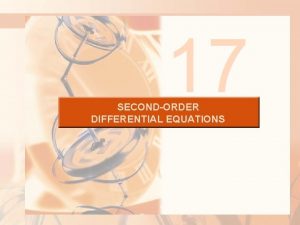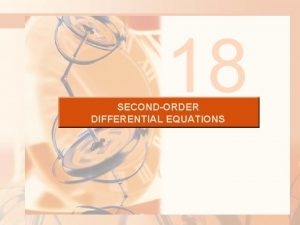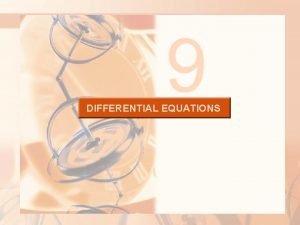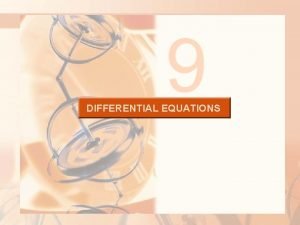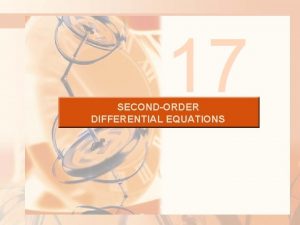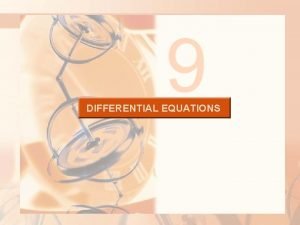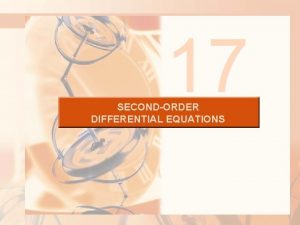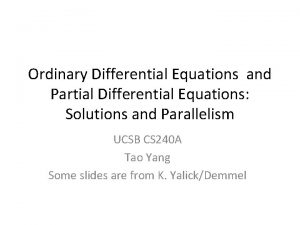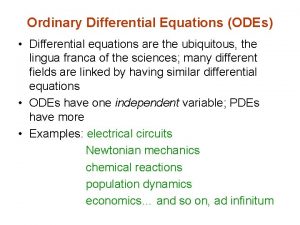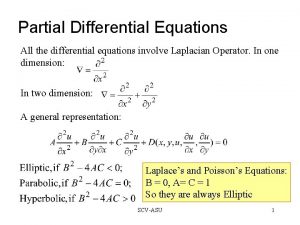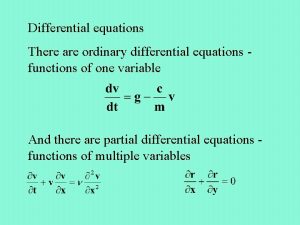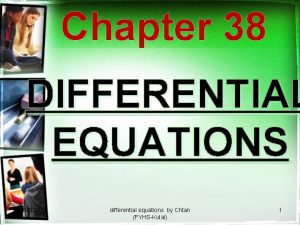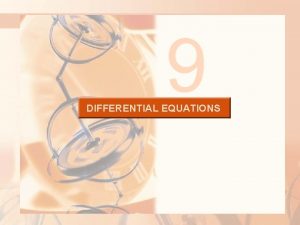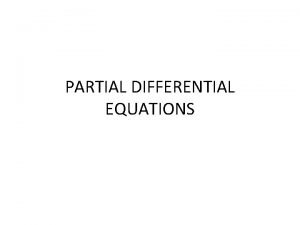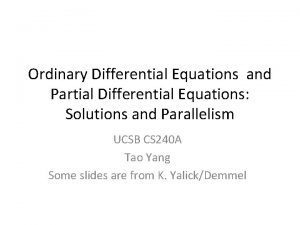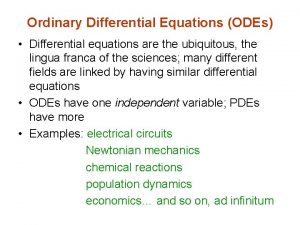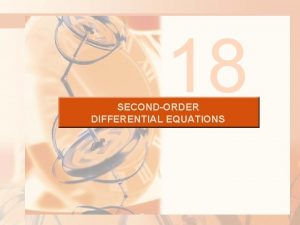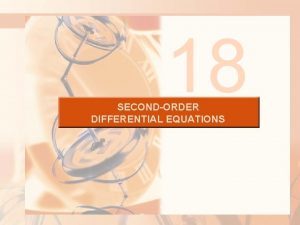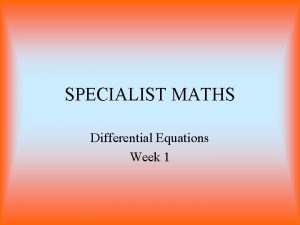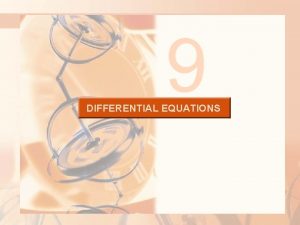9 DIFFERENTIAL EQUATIONS DIFFERENTIAL EQUATIONS Perhaps the most




































































- Slides: 68

9 DIFFERENTIAL EQUATIONS

DIFFERENTIAL EQUATIONS Perhaps the most important of all the applications of calculus is to differential equations.

DIFFERENTIAL EQUATIONS When physical or social scientists use calculus, more often than not, it is to analyze a differential equation that has arisen in the process of modeling some phenomenon they are studying.

DIFFERENTIAL EQUATIONS It is often impossible to find an explicit formula for the solution of a differential equation. § Nevertheless, we will see that graphical and numerical approaches provide the needed information.

DIFFERENTIAL EQUATIONS 9. 1 Modeling with Differential Equations In this section, we will learn: How to represent some mathematical models in the form of differential equations.

MODELING WITH DIFFERENTIAL EQUATIONS In describing the process of modeling in Section 1. 2, we talked about formulating a mathematical model of a real-world problem through either: § Intuitive reasoning about the phenomenon § A physical law based on evidence from experiments

DIFFERENTIAL EQUATION The model often takes the form of a differential equation. § This is an equation that contains an unknown function and some of its derivatives.

MODELING WITH DIFFERENTIAL EQUATIONS This is not surprising. § In a real-world problem, we often notice that changes occur, and we want to predict future behavior on the basis of how current values change.

MODELING WITH DIFFERENTIAL EQUATIONS Let’s begin by examining several examples of how differential equations arise when we model physical phenomena.

MODELS OF POPULATION GROWTH One model for the growth of a population is based on the assumption that the population grows at a rate proportional to the size of the population.

MODELS OF POPULATION GROWTH That is a reasonable assumption for a population of bacteria or animals under ideal conditions, such as: § § Unlimited environment Adequate nutrition Absence of predators Immunity from disease

MODELS OF POPULATION GROWTH Let’s identify and name the variables in this model: § t = time (independent variable) § P = the number of individuals in the population (dependent variable)

MODELS OF POPULATION GROWTH The rate of growth of the population is the derivative d. P/dt.

POPULATION GROWTH MODELS Equation 1 Hence, our assumption that the rate of growth of the population is proportional to the population size is written as the equation where k is the proportionality constant.

POPULATION GROWTH MODELS Equation 1 is our first model for population growth. § It is a differential equation because it contains an unknown function P and its derivative d. P/dt.

POPULATION GROWTH MODELS Having formulated a model, let’s look at its consequences.

POPULATION GROWTH MODELS If we rule out a population of 0, then P(t) > 0 for all t So, if k > 0, then Equation 1 shows that: P’(t) > 0 for all t

POPULATION GROWTH MODELS This means that the population is always increasing. § In fact, as P(t) increases, Equation 1 shows that d. P/dt becomes larger. § In other words, the growth rate increases as the population increases.

POPULATION GROWTH MODELS Equation 1 asks us to find a function whose derivative is a constant multiple of itself. § We know from Chapter 3 that exponential functions have that property. § In fact, if we let P(t) = Cekt, then P’(t) = C(kekt) = k(Cekt) = k. P(t)

POPULATION GROWTH MODELS Thus, any exponential function of the form P(t) = Cekt is a solution of Equation 1. § In Section 9. 4, we will see that there is no other solution.

POPULATION GROWTH MODELS Allowing C to vary through all the real numbers, we get the family of solutions P(t) = Cekt, whose graphs are shown.

POPULATION GROWTH MODELS However, populations have only positive values. § So, we are interested only in the solutions with C > 0. § Also, we are probably concerned only with values of t greater than the initial time t = 0.

POPULATION GROWTH MODELS The figure shows the physically meaningful solutions.

POPULATION GROWTH MODELS Putting t = 0, we get: P(0) = Cek(0) = C § The constant C turns out to be the initial population, P(0).

POPULATION GROWTH MODELS Equation 1 is appropriate for modeling population growth under ideal conditions. However, we have to recognize that a more realistic model must reflect the fact that a given environment has limited resources.

POPULATION GROWTH MODELS Many populations start by increasing in an exponential manner. However, the population levels off when it approaches its carrying capacity K (or decreases toward K if it ever exceeds K. )

POPULATION GROWTH MODELS For a model to take into account both trends, we make two assumptions: 1. if P is small. (Initially, the growth rate is proportional to P. ) 2. if P > K. (P decreases if it ever exceeds K. )

POPULATION GROWTH MODELS Equation 2 A simple expression that incorporates both assumptions is given by the equation § If P is small compared with K, then P/K is close to 0. So, d. P/dt ≈ k. P § If P > K, then 1 – P/K is negative. So, d. P/dt < 0

LOGISTIC DIFFERENTIAL EQUATION Equation 2 is called the logistic differential equation. § It was proposed by the Dutch mathematical biologist Pierre-François Verhulst in the 1840 s—as a model for world population growth.

LOGISTIC DIFFERENTIAL EQUATIONS In Section 9. 4, we will develop techniques that enable us to find explicit solutions of the logistic equation. § For now, we can deduce qualitative characteristics of the solutions directly from Equation 2.

POPULATION GROWTH MODELS We first observe that the constant functions P(t) = 0 and P(t) = K are solutions. § This is because, in either case, one of the factors on the right side of Equation 2 is zero.

EQUILIBRIUM SOLUTIONS This certainly makes physical sense. If the population is ever either 0 or at the carrying capacity, it stays that way. § These two constant solutions are called equilibrium solutions.

POPULATION GROWTH MODELS If the initial population P(0) lies between 0 and K, then the right side of Equation 2 is positive. § So, d. P/dt > 0 and the population increases.

POPULATION GROWTH MODELS However, if the population exceeds the carrying capacity (P > K), then 1 – P/K is negative. § So, d. P/dt < 0 and the population decreases.

POPULATION GROWTH MODELS Notice that, in either case, if the population approaches the carrying capacity (P → K), then d. P/dt → 0. § This means the population levels off.

POPULATION GROWTH MODELS So, we expect that the solutions of the logistic differential equation have graphs that look something like these.

POPULATION GROWTH MODELS Notice that the graphs move away from the equilibrium solution P = 0 and move toward the equilibrium solution P = K.

MODELING WITH DIFFERENTIAL EQUATIONS Let’s now look at an example of a model from the physical sciences.

MODEL FOR MOTION OF A SPRING We consider the motion of an object with mass m at the end of a vertical spring.

MODEL FOR MOTION OF A SPRING In Section 6. 4, we discussed Hooke’s Law. § If the spring is stretched (or compressed) x units from its natural length, it exerts a force proportional to x: restoring force = -kx where k is a positive constant (the spring constant).

SPRING MOTION MODEL Equation 3 If we ignore any external resisting forces (due to air resistance or friction) then, by Newton’s Second Law, we have:

SECOND-ORDER DIFFERENTIAL EQUATION This is an example of a second-order differential equation. § It involves second derivatives.

SPRING MOTION MODEL Let’s see what we can guess about the form of the solution directly from the equation.

SPRING MOTION MODEL We can rewrite Equation 3 in the form § This says that the second derivative of x is proportional to x but has the opposite sign.

SPRING MOTION MODEL We know two functions with this property, the sine and cosine functions. § It turns out that all solutions of Equation 3 can be written as combinations of certain sine and cosine functions.

SPRING MOTION MODEL This is not surprising. § We expect the spring to oscillate about its equilibrium position. § So, it is natural to think that trigonometric functions are involved.

GENERAL DIFFERENTIAL EQUATIONS In general, a differential equation is an equation that contains an unknown function and one or more of its derivatives.

ORDER The order of a differential equation is the order of the highest derivative that occurs in the equation. § Equations 1 and 2 are first-order equations. § Equation 3 is a second-order equation.

INDEPENDENT VARIABLE In all three equations, the independent variable is called t and represents time. However, in general, it doesn’t have to represent time.

INDEPENDENT VARIABLE Equation 4 For example, when we consider the differential equation y’ = xy it is understood that y is an unknown function of x.

SOLUTION A function f is called a solution of a differential equation if the equation is satisfied when y = f(x) and its derivatives are substituted into the equation. § Thus, f is a solution of Equation 4 if f’(x) = xf(x) for all values of x in some interval.

SOLVING DIFFERENTIAL EQUATIONS When we are asked to solve a differential equation, we are expected to find all possible solutions of the equation. § We have already solved some particularly simple differential equations—namely, those of the form y’ = f(x)

SOLVING DIFFERENTIAL EQUATIONS For instance, we know that the general solution of the differential equation y’ = x 3 is given by where C is an arbitrary constant.

SOLVING DIFFERENTIAL EQUATIONS However, in general, solving a differential equation is not an easy matter. § There is no systematic technique that enables us to solve all differential equations.

SOLVING DIFFERENTIAL EQUATIONS In Section 9. 2, though, we will see how to draw rough graphs of solutions even when we have no explicit formula. We will also learn how to find numerical approximations to solutions.

SOLVING DIFFERENTIAL EQNS. Example 1 Show that every member of the family of functions is a solution of the differential equation

SOLVING DIFFERENTIAL EQNS. Example 1 We use the Quotient Rule to differentiate the expression for y:

SOLVING DIFFERENTIAL EQNS. Example 1 The right side of the differential equation becomes:

SOLVING DIFFERENTIAL EQNS. Example 1 Therefore, for every value of c, the given function is a solution of the differential equation.

SOLVING DIFFERENTIAL EQNS. The figure shows graphs of seven members of the family in Example 1. § The differential equation shows that, if y ≈ ± 1, then y’ ≈ 0. § This is borne out by the flatness of the graphs near y = 1 and y = -1.

SOLVING DIFFERENTIAL EQNS. When applying differential equations, we are usually not as interested in finding a family of solutions (the general solution) as we are in finding a solution that satisfies some additional requirement. § In many physical problems, we need to find the particular solution that satisfies a condition of the form y(t 0) = y 0

INITIAL CONDITION & INITIAL-VALUE PROBLEM This is called an initial condition. The problem of finding a solution of the differential equation that satisfies the initial condition is called an initial-value problem.

INITIAL CONDITION Geometrically, when we impose an initial condition, we look at the family of solution curves and pick the one that passes through the point (t 0, y 0).

INITIAL CONDITION Physically, this corresponds to measuring the state of a system at time t 0 and using the solution of the initial-value problem to predict the future behavior of the system.

INITIAL CONDITION Example 2 Find a solution of the differential equation that satisfies the initial condition y(0) = 2.

INITIAL CONDITION Example 2 Substituting the values t = 0 and y = 2 into the formula from Example 1, we get:

INITIAL CONDITION Example 2 Solving this equation for c, we get: 2 – 2 c = 1 + c This gives c = ⅓.

INITIAL CONDITION Example 2 So, the solution of the initial-value problem is:
 Perhaps one day a millionaire will ask you to marry him
Perhaps one day a millionaire will ask you to marry him What is an adverb of possibility
What is an adverb of possibility What is perhaps
What is perhaps What is perhaps
What is perhaps Modal auxiliary verbs
Modal auxiliary verbs Double concept modals examples
Double concept modals examples Modal verbs worksheet
Modal verbs worksheet Modal auxiliary verbs
Modal auxiliary verbs Truth may perhaps come to the price of a pearl
Truth may perhaps come to the price of a pearl Hát kết hợp bộ gõ cơ thể
Hát kết hợp bộ gõ cơ thể Frameset trong html5
Frameset trong html5 Bổ thể
Bổ thể Tỉ lệ cơ thể trẻ em
Tỉ lệ cơ thể trẻ em Gấu đi như thế nào
Gấu đi như thế nào Chụp tư thế worms-breton
Chụp tư thế worms-breton Hát lên người ơi
Hát lên người ơi Các môn thể thao bắt đầu bằng tiếng bóng
Các môn thể thao bắt đầu bằng tiếng bóng Thế nào là hệ số cao nhất
Thế nào là hệ số cao nhất Các châu lục và đại dương trên thế giới
Các châu lục và đại dương trên thế giới Công thức tính độ biến thiên đông lượng
Công thức tính độ biến thiên đông lượng Trời xanh đây là của chúng ta thể thơ
Trời xanh đây là của chúng ta thể thơ Cách giải mật thư tọa độ
Cách giải mật thư tọa độ Làm thế nào để 102-1=99
Làm thế nào để 102-1=99 Phản ứng thế ankan
Phản ứng thế ankan Các châu lục và đại dương trên thế giới
Các châu lục và đại dương trên thế giới Thể thơ truyền thống
Thể thơ truyền thống Quá trình desamine hóa có thể tạo ra
Quá trình desamine hóa có thể tạo ra Một số thể thơ truyền thống
Một số thể thơ truyền thống Cái miệng nó xinh thế chỉ nói điều hay thôi
Cái miệng nó xinh thế chỉ nói điều hay thôi Vẽ hình chiếu vuông góc của vật thể sau
Vẽ hình chiếu vuông góc của vật thể sau Thế nào là sự mỏi cơ
Thế nào là sự mỏi cơ đặc điểm cơ thể của người tối cổ
đặc điểm cơ thể của người tối cổ V cc cc
V cc cc Vẽ hình chiếu đứng bằng cạnh của vật thể
Vẽ hình chiếu đứng bằng cạnh của vật thể Fecboak
Fecboak Thẻ vin
Thẻ vin đại từ thay thế
đại từ thay thế điện thế nghỉ
điện thế nghỉ Tư thế ngồi viết
Tư thế ngồi viết Diễn thế sinh thái là
Diễn thế sinh thái là Các loại đột biến cấu trúc nhiễm sắc thể
Các loại đột biến cấu trúc nhiễm sắc thể Số nguyên tố là số gì
Số nguyên tố là số gì Tư thế ngồi viết
Tư thế ngồi viết Lời thề hippocrates
Lời thề hippocrates Thiếu nhi thế giới liên hoan
Thiếu nhi thế giới liên hoan ưu thế lai là gì
ưu thế lai là gì Khi nào hổ mẹ dạy hổ con săn mồi
Khi nào hổ mẹ dạy hổ con săn mồi Khi nào hổ con có thể sống độc lập
Khi nào hổ con có thể sống độc lập Sơ đồ cơ thể người
Sơ đồ cơ thể người Từ ngữ thể hiện lòng nhân hậu
Từ ngữ thể hiện lòng nhân hậu Thế nào là mạng điện lắp đặt kiểu nổi
Thế nào là mạng điện lắp đặt kiểu nổi Differential equations projects
Differential equations projects Exact differential equation ppt
Exact differential equation ppt Pde paula
Pde paula Cengage differential equations
Cengage differential equations Non-linear ode
Non-linear ode Kutta
Kutta Carrying capacity equation calculus
Carrying capacity equation calculus Differential equations definition
Differential equations definition Separation of variables
Separation of variables Method of characteristics pde
Method of characteristics pde First order ode
First order ode Integrating factor of differential equation
Integrating factor of differential equation Euler's differential equation
Euler's differential equation Separation of variables differential equations
Separation of variables differential equations Natural solution
Natural solution Runge kutta second order formula
Runge kutta second order formula What is a first order equation
What is a first order equation Definition and classification of differential equations
Definition and classification of differential equations




